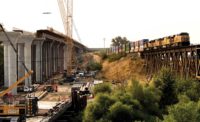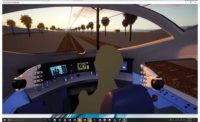As California prepares for a new governor—who may or may not be a supporter of the high-speed rail project now under construction—the California High-Speed Rail Authority is moving forward with environmental documents for the Los Angeles-area sections.
Last month, the authority released its draft 2018 business plan under new leadership that includes former California State Transportation Agency Secretary Brian Kelly as CEO. The new plan indicates that the estimated cost for the first phase has increased by 20%, to $77 billion.
A team of Tutor Perini, Zachry and Parsons, which is building the first 29-mile section in the Central Valley under a $1.4-billion contract, received a $63-million change order in 2016 and a completion extension from 2017 to 2019. Delays in acquiring right-of-way and relocating utilities were to blame, said Ron Tutor, chairman and CEO of Tutor Perini.
Along with third-party agreement issues, “the pitfalls were the cities and railroads,” Tutor told attendees at the US High Speed Rail Association’s West Coast Rail Conference held in Los Angeles March 6-8.
The CHSRA in its draft business plan pledged to utilize lessons learned moving forward. “The program is adding construction management expertise and expanding project controls expertise in the field and at the program level,” the plan stated. “Over the next several months, the Authority will expand its reporting tools to provide project managers with real-time performance information and to support the more structured and formalized change control process.”
Michelle Boehm, CHSRA regional director, noted that right-of-way won’t be an issue for future work north of Burbank that will include major tunneling. Environmental reviews are underway for alignments including up to 50 miles’ worth of tunnels in three mountain ranges.
The high-speed rail work is just one component of a transportation renaissance taking place in California, especially the Los Angeles area, panelists noted. “Los Angeles is completely poised to transform itself,” said Katherine Perez-Estolano, city leader with Arup, noting unprecedented local support and funding. She added that other developing technologies such as Elon Musk’s Hyperloop “are advances we need not be afraid of.”
High-speed rail in the U.S. continues to face opposition, especially from Republicans. One exception is Robert Gleason, former chairman of Pennsylvania’s Republican Party and a HSR supporter who said, “We really need to start the drumbeat” of advocacy in Washington.




Post a comment to this article
Report Abusive Comment